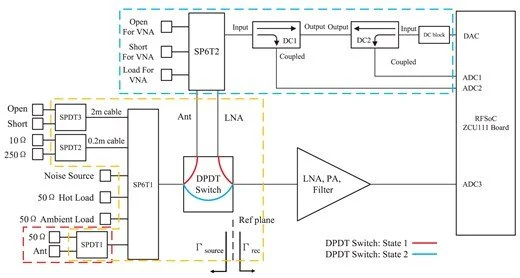
RFSoC receiver calibration system for 21-cm global spectrum experiments from space: the CosmoCube case
The CosmoCube project plans to deploy a global 21-cm spectrometer with 10–100 MHz observation band in a lunar orbit. The farside part of such an orbit, i.e. the part of orbit behind the Moon, offers an ideal site for accurately measuring the 21-cm signal from the dark ages, cosmic dawn, and epoch of reionization, as the effects of the Earth’s ionosphere, artificial radio frequency interference, and complex terrain and soil are all avoided. Given the limitations of a satellite platform, we propose a receiver calibration system design based on a radio frequency system-on-chip, consisting of a vector network analyser (VNA) subsystem, and a source switching subsystem. We introduce the measurement principle of the VNA, and discuss the effect of quantization error. The accuracy, stability, and trajectory noise of the VNA are tested in laboratory experiments. We also present the design of the source-switching subsystem, generating mock data sets, showing that the imperfect return loss, insertion loss, and isolation of surface-mounted microwave switches have a minimal effect on the sky foreground fitting residuals, which are within ±10 mK under optimal fitting condition. When all possible measurement errors in reflection coefficients and physical temperatures are taken into account, the foreground fitting residuals for the 50–90 MHz part of the spectrum remain around ±20 mK.

The spectrometer development of CosmoCube, lunar orbiting satellite to detect 21-cm hydrogen signal from cosmic dark ages
The cosmic Dark Ages represent a pivotal epoch in the evolution of the Universe, marked by the emergence of the first cosmic structures under the influence of dark matter. The 21-cm hydrogen line, emanating from the hyperfine transition of neutral hydrogen, serves as a critical probe into this era. We describe the development and implementation of the spectrometer for CosmoCube, a novel lunar orbiting CubeSat designed to detect the redshifted 21-cm signal within the redshift range of 13 to 150. Our instrumentation utilizes a Xilinx Radio Frequency System-on-Chip (RFSoC), which integrates both Analog-to-Digital Converters (ADCs) and Digital-to-Analog Converters (DACs), tailored for the spectrometer component of the radiometer. This system is characterized by a 4096 FFT length at 62.5 kHz steps using a Polyphase Filter Bank (PFB), achieving an average Effective Number of Bits (ENOB) of 11.5 bits throughout the frequency of interest, from 10 to 100 MHz. The spectrometer design is further refined through loopback tests involving both DAC and ADC of the RFSoC, with DAC outputs varying between high (+1 dBm) and low (−3 dBm) power modes to characterize system performance. The power consumption was optimized to 5.45 W using three ADCs and one DAC for the radiometer. Additionally, the stability of the ADC noise floor was investigated in a thermal chamber with environmental temperatures ranging from 5 to 40 ∘C. A consistent noise floor of approximately −152.5 dBFS/Hz was measured, with a variation of ±0.2 dB, ensuring robust performance under varying thermal conditions.
